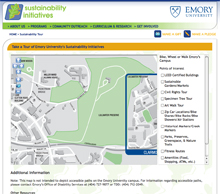Campus News
June 7, 2010
Explore campus from a new direction

Sustainability Map
It’s lunch hour. One option is to hike to the parking deck, jump in the car, choke on exhaust fumes in Clifton Road traffic and inhale a burrito on the way back.
A healthier alternative is to click on Emory’s new online Sustainability Map. Here you can find a bike share location or put on your walking shoes, take an art tour, grab lunch at one of the identified shopping locations and recycle your waste before returning to the office guilt-free.
Encouraging the campus community to get a little fresh air while helping the environment is one of the main goals of Emory’s new Walk N’ Roll campaign. Funded by an $18,000 grant from the nonprofit Urban Land Institute with matching funds from the University, the campaign builds on Emory’s efforts to reduce its carbon footprint — a measure of greenhouse gas emissions — by creating a pedestrian campus core to include walking, wheeling and biking.
“The map is a tool to integrate exercise and time outdoors into every person’s daily routine to promote our personal health and the health of the planet,” says Ciannat Howett, director of sustainability initiatives and the interactive map’s chief creator. “Emory has a unique ecosystem, history and culture, which the map highlights. Our hope is that the map helps people feel connected to Emory as a special place and that they will want to contribute to creating a sustainable campus.”
After requesting feedback from the community, students and staff worked tirelessly marking GPS coordinates, counting footsteps between sites and researching content in preparation for its launch last month. The current map is user-friendly, with a scroll-down menu and pop-up text boxes, highlighting historical points of interest; ATM, shopping and restaurant locations; green spaces; MARTA and Cliff routes; and walking tours and trails.
Click on Pitts Theology Library under the Civil Rights tour, for instance, and learn that the former chapel was the first stop on a four-day protest by the Black Student Alliance in 1969. Or, embark on a scavenger hunt for Emory’s LEED-certified “green” buildings.
The map underscores Emory’s commitment to sustainability, featuring educational gardens around campus, a compact fluorescent light bulb recycling center at Dobbs University Center and the farmers market in front of Cox Hall.
Video and audio podcasts of tours will be added to the map this fall, allowing users to stream additional content to their computers or cell phones.
Shelby Smith, an admissions program coordinator and staff sustainability representative for the School of Medicine, will use the tool to help orient incoming students in July. A fan of ginkgo trees, she plans to explore the map’s Specimen Tree tour.
“It’s wonderful to be able to have all of this information at our fingertips,” Smith says. “There are so many things to do on campus that are within walking distance.”
As part of the grant, all incoming College freshmen were required to attend a lecture on community design and public health in their Health 101 class last fall. The final component of the Walk N’ Roll campaign was the map’s official debut during The Congress for the New Urbanism’s annual meeting in May.
Howett’s office will conduct a follow-up survey this fall to determine if the map has inspired healthy, sustainable behavior.
“What we’ve been emphasizing is that you can integrate exercise into your daily life and be sustainable at the same time,” says Howett, who encourages everyone to check out the map.
